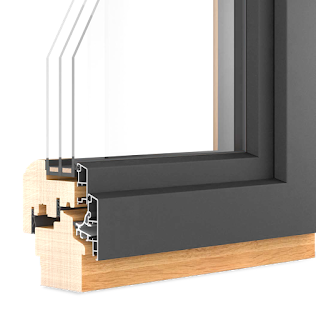 |
| German windows—the Mercedes Benz of fenestration. With the handle in one position, the sash tilts in; in another, it opens like a casement. When closed, it sealed flat-out airtight. |
With Germany’s harsh climate and high energy costs, weathertight, energy-efficient windows have always been indispensable. Not so here in the States: as little as thirty years ago, the average tract house window still consisted of flimsy aluminum frames, with a single sheet of 3/16” glass, hit-or-miss gasketing, and rinkydink extruded hardware. These windows were affordable in first cost, but in terms of energy efficiency, they were little better than a hole in the wall. But back then, who cared? America got its energy dirt cheap. From Boise to Buffalo, the remedy for a cold, leaky house was simple—turn up the thermostat.
 |
| By contrast, this is what most American homes had just thirty years ago: Flimsy, leaky, aluminum dreck. |
Only then did window manufacturers finally recognize the huge market for a window that was both affordable and energy-efficient. Nowadays, the best U.S.-made examples are just about on par with their German cousins, both in energy efficiency and construction quality. Some of the features to look for:
 |
| Triple glazing: Overkill for most U.S. climates, but maybe not so for sound attenuation. |
• Inert gases sealed between the panes of double and triple glazing. Gases such as argon conduct less heat than ordinary air, thereby improving the insulating value of the window assembly.
• Vastly improved hardware and gasketing, which provide an airtight seal against infiltration of cold outdoor air, along with thermal breaks to prevent heat from being conduct ed outdoors via the window frame. Aluminum, in particular, is a notoriously efficient thermal conductor, so many window manufacturers now interpose less conductive materials such vinyl or rubber between inner and outer frames to help stem the flow of heat.
 |
| Today, American windows are almost on par with European ones. Almost. |
Taken together, these improvements have saved countless millions of barrels of oil and kept who knows how much carbon out of the atmosphere. Granted, they took a generation to enter the mainstream of US building practices, but in the face of today's ever-more alarming changes in climate—well, better late than never.

No comments:
Post a Comment